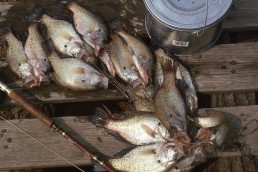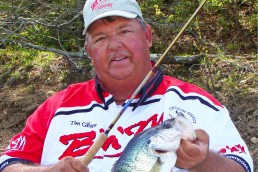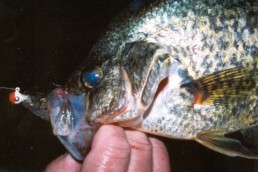Shallow Crappies Warm up the Spring Season
SHARE THIS POST
I’ve pursued the pleasant sport of fishing for arctic char in the Northwest Territory, for northern pike in Houghton Lake and cutthroats in the Wyoming high country, and sea trout along Chesapeake Bay. I like them all, but I must admit I’ve got a soft spot for one fish, and it’s one I seek it whenever possible—the ordinary crappie.
When I was a kid I visited our local lake each spring, fishing with creek-seined minnows to take these big, beautiful, silvery fish. I loved it though I can’t explain why. Maybe it’s the way they take a minnow so deliberately, mouthing the offering and moving slowly and then away with a bobber gradually sliding under. Or it’s just the way these panfish taste after they’re cooked in a skillet. Or, maybe it’s because it takes so little equipment to catch them.
Whatever the reason, the spring crappie season is upon us and many will be seeking them.
I’ve always thought that there are two ways to go crappie hunting. One is to gather up the family, a few rods decorated with thin pencil floats, some split shot and a number 6 hook. Next, we’ll seek out a fallen tree or brush pile on our favorite lake. The kids will fish or play along the bank, and hopefully the floats will sink often enough to allow you to assemble a modest bucket or a stringer of fish.
Are you enjoying this post?
You can be among the first to get the latest info on where to go, what to use and how to use it!
The second way to catch crappies is to actively hunt them, which means you must work at it a little, but you will catch more. If there’s a secret here, it’s to move—a phrase I’ve used in crappie articles before. You can still use minnows, a thin float, split shot and hook, but instead of sitting near one brush pile and staying there, try other places. Otherwise, you’ll skim the “cream” in a short time and spend the rest of your morning picking up only the occasional straggler that swims in.
Boat fishermen will do better using waxworms on small jigs with twister tails instead of minnows. White jigs with red heads are tops, but ordinary white works as do chartreuse and even pink ones, occasionally. With these inexpensive little offerings, row quietly along with a long crappie rod and dab the jig (or minnow) around every stump, fallen tree, drowned brush and stick up along the shore. And remember, fish one spot until the bite slacks off then move and move yet again.
Shore fishermen can do much the same—walk along the bank and dab their offerings here and there around every bit of cover. Again, it’s not relaxing and it takes effort. But if you want to make a good catch, this is how you do it. I’ve fished for crappies from the Ohio River to Lake Erie, but it’s the latter that I love to visit each spring because the crappies there grow huge. East, West and Middle harbors have produced some heavy stringers for me, but it can be hit or miss. I’ve hand-launched a small canoe in Middle Harbor five different times in successive years and have found the fish in there only twice. However, on those two occasions I filled a stringer with mostly black crappies that ran to 15 inches, and were huge, thick-bodied fish that came flapping to the boat and gladdened my eye. The other three times I just had to “settle” for channel cats.
Finally, there are lots of lakes in Ohio that hold good crappies: Charles Mill, Clear Fork, Indian, Buckeye, Salt Fork and Pymatuning lakes. All that’s needed at these are a few warm days to heat up the shallows, and the crappies will be waiting.
MWO
SHARE THIS POST
Did you enjoy this post?
You can be among the first to get the latest info on where to go, what to use and how to use it!
Richard Martin
Dick Martin is a retired biology teacher with a bachelor’s degree in Biology from Ohio U. and a master’s degree in Zoology from Ohio State U. He is a longtime member of Outdoor Writers of Ohio and Outdoor Writers Association of America. He and has written many outdoor articles on a variety of subjects.



